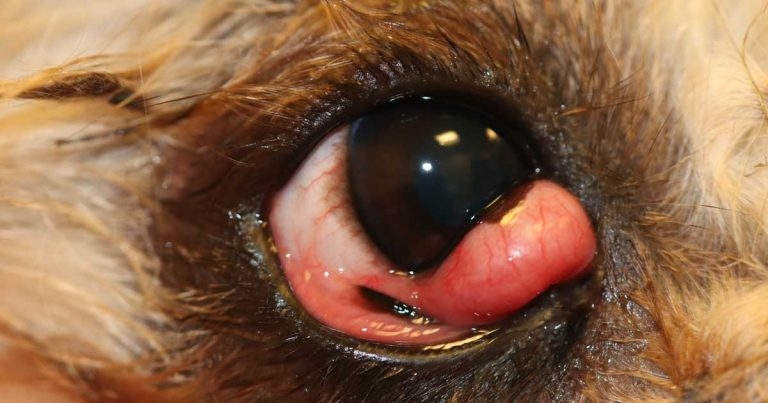28 Jan 2022
The RVC’s VetCompass programme has published the results from the world’s largest study into cherry eye in dogs, which identified 17 breeds at increased risk of developing the condition.

If left untreated, cherry eye can cause discomfort and lead to complications such as dry eye, conjunctivitis and eye ulceration. Image: © RVC.
Brachycephalic breeds are up to seven times more likely than dogs with normal skull length to suffer the painful condition known as cherry eye.
The RVC’s VetCompass programme has published the results from the world’s largest study into cherry eye in dogs, which identified 17 breeds at increased risk of developing the condition, including the Neapolitan mastiff, English bulldog, Lhasa apso and great Dane, among others.
Named after the pink mass that appears from the inner corner of the dog’s eye, cherry eye is a condition clinically known as a prolapsed nictitating membrane gland.
It is a result of the gland on the inner side of the third eyelid prolapsing, becoming red and swollen, and covering part of the eye.
If left untreated, the condition can cause discomfort and lead to complications such as dry eye, conjunctivitis and eye ulceration. Surgery is usually required to treat the condition and reposition the affected gland.
Led by the RVC’s VetCompass programme, researchers followed the anonymised veterinary health records of 905,553 dogs for a year and identified that 0.20 per cent (1,802 dogs) were affected by the condition.
Some breeds, especially those that are brachycephalic, were at much higher risk.
The breeds with the highest risk included the Neapolitan mastiff, which were found to be 34.3 times more likely to develop the condition compared to a cross-breed.
Not far behind was the English bulldog (×24.1), Lhasa apso (×12.4), American cocker spaniel (×11.6), puggle (×9.5), great Dane (×6.2) and St Bernard (×5.3).
Some of the most popular designer breeds of flat-faced dogs were also hugely affected, such as the “puggle” (pug-beagle-cross; 2.1 per cent) and “jug” (Jack Russell terrier-pug-cross; 1.2 per cent), suggesting the recent craze for designer cross-breeds does not eliminate health issues associated with the parental pure breeds.
Dan O’Neill, associate professor in companion animal epidemiology at the RVC and lead author of the paper, said: “Given that humans designed dog breeds in the first place, we all carry a heavy responsibility to constantly improve our designs to breed away from poor health for these dogs.
“The hugely increased risk of cherry eye in popular flat-faced breeds, such as English bulldogs suggests we have some way to go before we can consider many flat-faced breeds as designed for optimal health.
“The findings from this study will hopefully help prospective owners make better informed choices when purchasing a dog. We urge all would-be dog owners to follow advice from the UK Brachycephalic Working Group to stop and think before buying a flat-faced dog.”
Researchers also found the average age at first diagnosis of cherry eye was 0.6 years and that 16 breeds showed reduced risk of cherry eye compared to cross-bred dogs.
Breeds with the lowest risk included German shepherd dogs (×0.03), West Highland white terriers (x 0.06), English springer spaniels (×0.07), Labrador retrievers (×0.12) and lurchers (×0.12).
Overall, purebred dogs were found to be 1.4 times more likely to develop cherry eye compared with cross-bred dogs. The RVC hopes the awareness of the link between the brachycephalic skull shape of many breeds and the likelihood of these dogs developing cherry eye can help to inform the general public when deciding on which breed they should purchase.
BVA president Justine Shotton said: “This important study offers strong evidence linking certain breed types with a higher predisposition to cherry eye.
“It is of particular interest to see a significant correlation between skull length and cherry eye, meaning that flat-faced breeds, such as English bulldogs are at increased risk of developing this condition.
“We hope the research helps better understand and address the health and welfare impacts resulting from brachycephaly.”
To read the paper, visit https://doi.org/10.1371/journal.pone.0260538